Full-time vs. freelance : Crunching the numbers
Let’s say you’re starting the hardware company of your dreams and need to go from idea to production. Let’s also accept the reality that you’re probably underfunded and need a ton of help to get there.
You have a few options for how to build your team:
- Hire for the roles you need. Pay competitive wages to attract the top talent, cover their insurance and 401K contributions, buy the hardware and software licenses they need, and start development.
- Find top-notch freelancers who you can pay by the hour to build your hardware.
- Go to a freelance marketplace, choose the cheapest option, and watch them like a hawk for the next 18 months — leaving you almost no time to sell or grow the business.
- Find a design or engineering firm, pay a large lump of cash upfront, and wait for updates.
The typical hardware product needs the following roles:
Industrial Designer: Designs the form of the product and specifies the color, material, and finish of the parts. Focused on user experience as well as aesthetics.
Electrical Engineer: Responsible for the design and development of printed circuit boards, specifying the correct components, and ensuring the product will pass any and all certifications needed.
Product Design Engineer: A mechanical engineer focused on taking concepts from the industrial designer and turning them into manufacturable parts. Works closely with the factories to ensure the product can be made repeatedly and to a high-quality standard.
Supply Chain Manager: Identifies the manufacturers of all components and negotiates pricing, lead times, and coordinates shipping.
Project Manager: The glue between all things hardware, ensuring everything is done on time and nobody is blocking progress.
We’ll post a more in-depth description of typical hardware development and marketing roles in a future post.
And this is just to get the hardware built!
Don’t forget you need a brand, a logo, renders or images of the product, and you need to build a website and a have a go-to market strategy to be successful.
Hiring internally
Let’s look at some fun data from Zip Recruiter now for the average national salaries for a few of these roles you’ll need to hire. Keep in mind that these salaries are much higher in big cities such as NYC, LA, and San Francisco.

Now, let’s not forget to factor in insurance and 401K! According to Joseph G. Hadzima at MIT, an easy method of calculating this rate is to multiply the salary by 1.4.

Let’s just focus on that hardware design team now.
Are you willing (and able) to spend between $605,500 and $850,500 a year on a hardware design team?
Time utilization
Ideally your team comes into the office and kicks ass all day every day. But, in reality, they’re context switching and wasting time and only work around 2.5 hours per day.
This doesn’t even factor in downtime due to lead times — when you need to wait 6 weeks for your tooled plastic parts to arrive or the next set of assembled circuit boards to be fabricated.
Additionally, hardware projects tend to be done in a waterfall approach. Industrial design may have more upfront work while the product design engineer is blocked until the industrial design is completed. (In my past roles at larger companies, this is where I got really good at playing ping pong.)
We can dive into a real-life informal project to see how time is spent across roles. If you hate graphs, now’s your time to keep scrolling!
Let’s look at the data
The following data is from an actual informal project that’s in progress now. It’s for a fairly complex consumer electronics project that needs to look fantastic and work in some tough scenarios. All data was obtained from the informal backend system, which records the time spent by a freelancer on a specific project and specific tasks (design, meeting, testing, etc.).
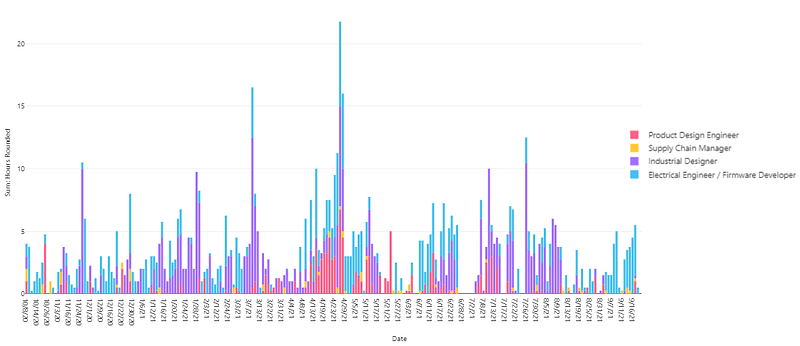
Each color on this graph represents a different role. Rarely are we spending more than 5 combined hours a day on this project across a team of 4.
Drilling down, you can see how the time allocation fluctuates drastically by role.
Industrial Designer
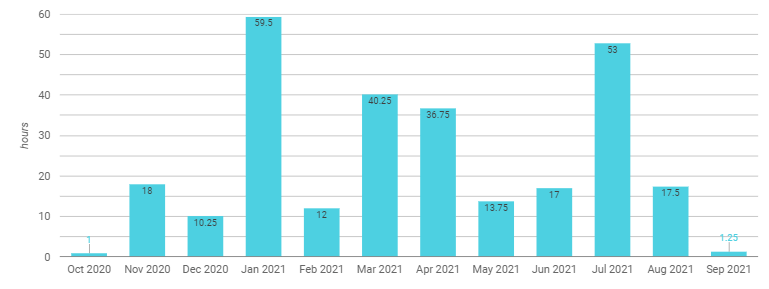
The industrial designer hit the ground running in November, creating quick design directions to share with the client. Some design iteration was done in December, and the final design direction was chosen in early January. Most work was done during January to create the near-final form, testing the ergonomics and refining the design. Spikes of work can be seen in April when prototypes arrived and July as a cosmetic model and renders were made for a video shoot.
Peak: 59.5 hours
Average: 23.3 hours
Product Design Engineer
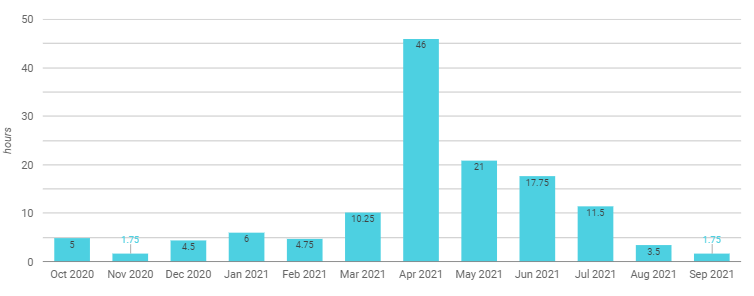
The lion’s share of the product design engineer’s work began 7 months after the project kicked-off. They were blocked by industrial design refinement, research into the electronics, and confirming parts could be sourced. A decent chunk of work was spent afterwards evaluating and iterating on the 3D-printed prototypes and creating a request for quotation (RFQ) package to send off to vendors.
Peak: 46 hours
Average: 11.14 hours a month
Electrical Engineer/Firmware Developer
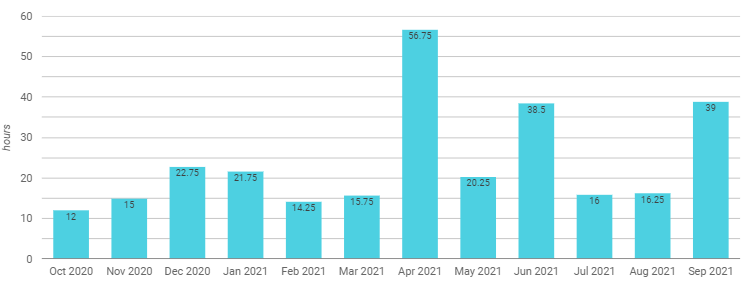
Since the electrical engineer was also doing the firmware development, they stayed consistently busier than most. We can see a similar peak in April when prototypes arrived, a peak in June for product testing, followed by another peak in September for firmware refinement.
Peak: 56.75 hours a month
Average: 24 hours a month
Supply Chain Manager
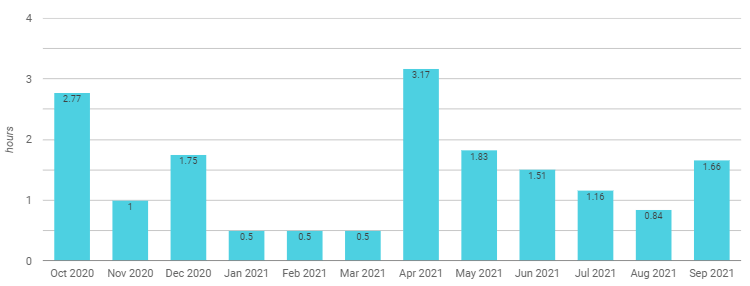
Rarely exceeding 1.5 hours a month, the supply chain manager identified potential vendors for components and facilitated introductions with the team and fielded questions for sourcing and manufacturing. The peak in April correlates with receiving prototype parts.
Peak: 3.17 hours
Average: 1.43 hours
What does this all mean?
OK, if you scrolled past the graphs, I don’t blame you. Here’s the TL;DR:
- Rarely is a team fully utilized on a project due to lead times, blockers, and the natural pace of development.
- Work is inconsistent and there are spikes during the design phase, prototype phase, and testing phases.
- There are large lulls in between these phases as the team waits for the next thing, or whittles away at small tasks.
If you’re a small startup, it’s safe to assume you’re focusing on one or two projects to launch at a time, maximum.
Looking at the data above, your team is underutilized nearly 90% of the time even if they work on two projects at once.
You’re paying for that downtime if you hire internally.
So, let’s crunch some numbers
Using the above example project, we can see the total amount of time spent by each role across 12 months:
- Industrial designer: 280 hours total
- Product design engineer: 134 hours total
- Electrical engineer/firmware developer: 288 hours total
- Supply chain manager: 17 hours total
And this is across a whole year!
Using the total cost from Figure 2 above, we can do some simple math. Assuming the standard 2,087 hours in a work year, we can back out the hourly rate for each role:

Oof! Now let’s assume that instead of hiring full-time, you decided to hire top-tier freelancers to work on the project through, perhaps, us.
Using average freelancer hourly rates, we can see the total cost for this project:

It costs around $120,000 for 1 years of a team of 4 hardware experts to design and develop a complex electronics project.
That is the same total cost as hiring a single electrical engineer for a year!
Now, those hourly rates may shock you at first, but think about what you’re getting at that rate:
- Experience: Most of our team have been working for 7–10 years.
- Equipment: No need to buy computers, printers, or hardware.
- Licenses: Freelancers pay for their own software licenses, which can vary from $2,500–7,000 a year.
- No benefits: Freelancers need to cover their own insurance, 401K, and increased tax burden. (This is a larger problem that needs to be addressed, but American healthcare is a nightmare!)
But I can find who I need on a freelance marketplace! Why would I use a group like informal?
At the risk of sounding like my mother, you get what you pay for. Sure, you can find an engineer on a freelance marketplace who may be able to work at $40/hour, but now you need to repeat that across all your roles. Then you need to get them to all work and communicate together, most likely across multiple programs and time zones.
Many of our clients report having to supervise freelancers on these marketplaces and going through numerous revisions for even the simplest of things.
If you’re paying $40/hour but working 4x slower, you’re effectively paying $160 an hour for that freelancer.
This doesn’t factor in the time you need to babysit instead of doing your job.
When to hire internally
Of course, there are times when it makes sense to bite the bullet and make that full-time hire. If you’re going to have near-full utilization of an employee, it may make sense to hire internally. Additionally, if you’re working on a very complex project that will be difficult to transfer to another person in the future, you should consider hiring full-time. The most common role we’ve seen for full-time hires are firmware developers, since it’s difficult to onboard another person and have them pick up where someone left off.
Convinced yet?
Let’s chat and see if we can help you out. Shoot us an email and mention this article. We’ll be in touch shortly to help estimate your project. If you’re a minority-owned or women-owned business, we’ll happily give you a reduced rate!
❤ Sam and Nate